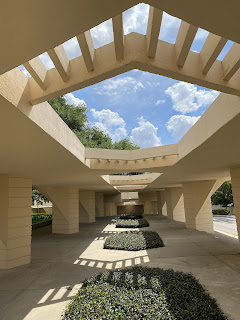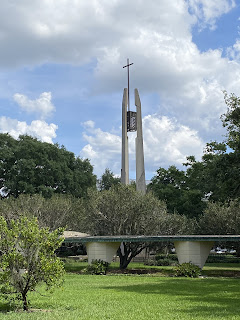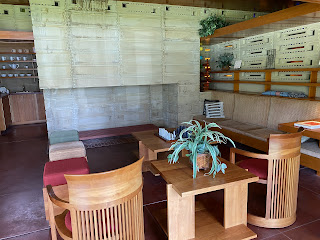In 2012, the Florida Southern College Historic District was designated a National Historic Landmark for being the largest single-site collection of Frank Lloyd Wright architecture in the world. Twenty-eight of Wright’s projects are National Historic Landmarks, including the campus of Florida Southern College (FSC) in Lakeland.
Frank Lloyd Wright (1867-1959), considered by many to be the greatest of all American architects, pioneered a style of “organic architecture” that connects buildings harmoniously with the natural landscape around them.
In the late 1930s, the then president of FSC resolved to find a new architect for the campus, one who could transform the small, obscure college into an institution of national consequence by creating a true “campus of tomorrow”. In 1938, at nearly 71 years of age, Wright set foot on the FSC campus for the first time. The landscape was not typical Floridian - it was located almost entirely on the slopes of a gently rolling 80-foot hill overlooking Lake Hollingsworth, and the vast majority of the campus was underdeveloped and covered with citrus trees. Wright remarked that he could envision buildings on this landscape that would grow “out of the ground and into the light - a Child of the Sun.”
Ruthven Plaza
All of the campus buildings designed by Wright are linked by the longest system of covered walkways in Wright’s career - now known as the Esplanade. Stretching more than a mile in total length, the Esplanade features uniformly designed columns that are said to evoke the orange trees that once filled the campus grounds.
The E.T. Roux Library was built in 1941. Due to labour shortages at that time, student labour, in exchange for tuition and board, was employed for the construction of the five initial Wright-designed buildings. During wartime, the construction crew - and the College’s student enrollment - was comprised almost entirely of women. After the College’s book collection exceeded the building’s design, in 1970 the Roux Library was repurposed as, and is still currently, an Administration Building.
Unfortunately it wasn’t working when I was there, but the Water Dome (completed in 1948) is the largest Wright-designed water feature in the world. The Water Dome is capable of creating a full dome of water reaching 45 feet in the air, thanks to 75 water jets that are positioned long the perimeter of a large circular pool.
Located in the heart of Wright’s campus plan, the Annie Pfeiffer Chapel - with its iconic 65-foot-tall bell tower - was the first building to be constructed, and would be the nation’s first college chapel with an architecturally modern design. Wright designed the chapel to be both the physical and spiritual centre of the campus.
The Annie Pfeiffer Chapel’s interior is defined by massive vaulted skylights framing the natural heavens above.
Chapel Garden outside the Annie Pfeiffer Chapel
The William H. Danforth Chapel was described by Wright as a “miniature cathedral” and houses Wright’s final, commissioned stained glass work.
The Polk County Science Building is the largest of Wright’s campus buildings and the final building to be completed (1958) at Florida Southern within the architect’s lifetime. It contains Wright’s only constructed Planetarium and is one of a small handful of buildings in his career to utilize aluminum for aesthetic elements.
The Pearce Centennial Tower was dedicated in 1985.
Ruth’s Rose Garden on the Florida Southern College campus is a prominent and beautiful landscape feature and with its 300 plants of near all 200 varieties, it is one of the largest and most genetically diverse collections of roses in the southeastern United States.
In 1939, Wright was commissioned for a single-family house, the first of an envisioned faculty-housing neighbourhood on campus. While this home was not utilized in Wright’s time because of funding issues, its construction, based entirely on Wright’s plans, was undertaken more than seven decades later. Completed in 2013, the Usonian house joins the ranks to become Florida Southern’s thirteenth Wright-designed structure.


































No comments:
Post a Comment